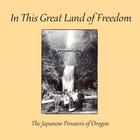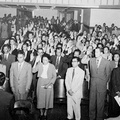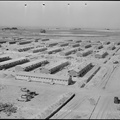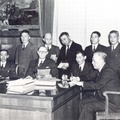Working as a hop picker
It is impossible to
Return to JapanHonda Fugetsu1
Before 1910, the majority of the Oregon Japanese population were male laborers who lived in a crude environment. Initially, most, if not all of them came to America not to settle, but to work and make money for their families in Japan. For these people, Portland was a temporary home to which they returned when they completed seasonal work. Until they found their next jobs, they stayed at Japanese hotels and ate at the inexpensive restaurants. When the economy was unfavorable, these migratory laborers were the first to suffer. In 1907, a Japanese student described the tragic life of his fellow immigrants in these words:
Everywhere in the nation, the recession hit hard….Railroad companies are firing laborers, and the daily wages dropped sharply from $1.45 to $1.10 and to $0.95….In the downtown [Portland], Japanese hotels are filled with the [unemployed] people who cannot afford to buy a regular meal. Most of them barely survive by eating a piece of bread and water everyday. It is really unbearable to see such misery.2
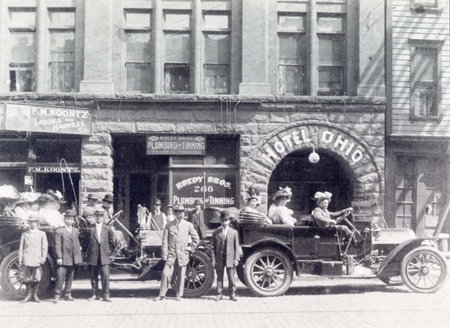
In the rural areas, the living conditions of Japanese immigrant laborers were equally poor. Some railroad workers reportedly lived in caves! An immigrant newspaper reporter who traveled into Huntington, Oregon, gave his vivid account of these cave homes:
To my surprise, I saw there was somebody watching us with his head sticking up above the ground. I realized it was a cave he had there. The man invited us, “Come in,” so we went down three or four mud steps. The inside was bigger than I expected. There, two Japanese about thirty years old looked at me and expressed their welcome, smiling. The cave was 16’ or 17’ square and about 7’ or 8’ high. On the ceiling – in other words, on the ground – they had put boards with canvas stretched over them, and on top of that, hay. They had two bunk beds.3
Others slept in tents or freight cars. Their daily meals were meager. In the early years, railroad workers generally ate flour-dumpling soup known as dango-jiru with bacon, vegetables, and occasionally bread. Probably wary of white people who regarded Japanese as ‘unassimilable’,” labor contractor Tadashichi required his workers to have “western style” meals like Americans and not to use miso [Japanese soup base], soy sauce, or rice. Ironically, the result of this “Americanization” in diet was harmful to the laborers and many reportedly suffered from night-blindness because of poor nutrition.4
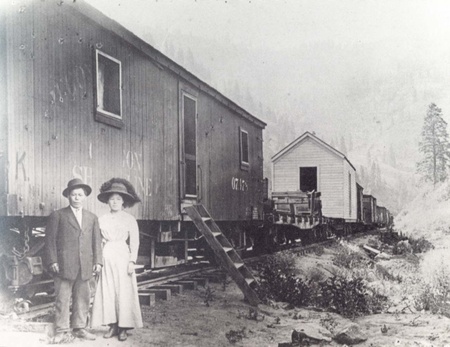
Gambling and prostitution flourished in the bachelor community. As early as 1891, a Japanese Consulate official found some 40 Japanese gamblers and pimps in Portland. He also reported the presence of 19 Japanese prostitutes in the city, many of whom had moved from Seattle and entered prostitution as wives of gamblers.5 Seventeen years later, another Japanese diplomat investigated the Portland Japanese community and depicted it as “obscene” and “even worse than Chinatown.” In his opinion, the living conditions of the immigrants showed “no progress.”6
An old-timer gave a vivid picture of early Japanese life in Portland. In the Japanese section of town, he worked as a dish washer in a Japanese restaurant from five in the morning until after midnight. Serving a meal for a dime, the restaurant catered to the Issei laborers who patronized neighboring gambling houses and brothels. He observed that Japanese gamblers liked to play cards, roulette, and hanafuda [Japanese card game]. Some people gambled away thousands of dollars, while others won as much in a matter of a night.7 In the eyes of many immigrant laborers, gambling seemed a short cut to their dream: returning home with money.
“There were some immigrants who sought to rid the community of these vices. Starting from 1893, Reverend Sadakichi Kawabe, who established the Portland Japanese Methodist Church, launched a campaign to reform public morals among Japanese residents. Community leaders such as Shintaro Takaki and Shinzaburo Ban gave their support to the campaign.8
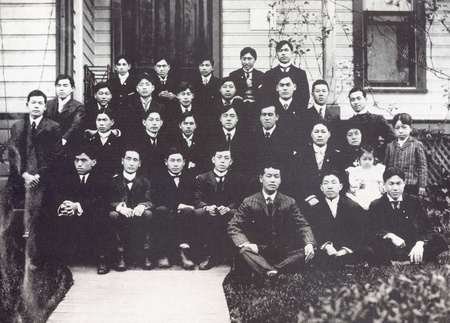
Shozui Wakabayashi, who came to Portland in 1903 as the first resident Buddhist minister, also contributed to the welfare of the early Japanese community. He found work for the young men and offered other services they needed. In addition to serving the spiritual and social needs of the city people, Wakabayashi also toured from loggers’ camp to camp and stayed with the laborers to whom he recited the Buddhist teachings. By 1911, the Oregon Buddhist Church expanded from two rented rooms to a newly constructed building, and parishioners numbered approximately 570.9
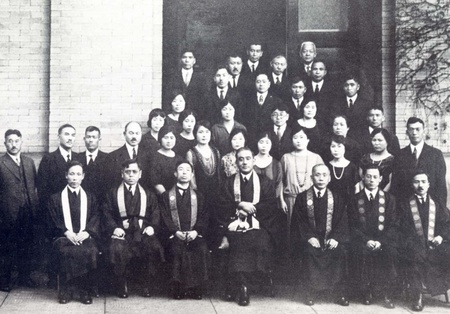
Honoring Daika Sonyu Ohtani from Japan
Portland, Oregon, ca. 1925
(Courtesy of J. Matsumoto – Japanese American National Museum [92.145.2])
Notes:
1. Tachibana Ginsha, Hokubei Haikushu (Los Angeles, Tachibana Ginsha, 1974), p. 37.
2. Letter from Masuo Yasui to T. Yasui, December 11, 1907, in Homer Yasui Personal Collection.
3. Kazuo Itom Issei: A History of Japanese Immigrants in North America, p. 344.
4. Ibid., pp. 291-302.
5. Gaimusho, Nihon Gaiko Bunsho, Vol. 24, pp. 498-499.
6. Gaimusho, Nihon Gaiko Bunsho: Taibei Mondai Keika Gaiyo (Tokyo: Gaimusho, 1972), pp. 198-199.
7. Kazuo Ito, Issei: A History of Japanese Immigrants in North America, p. 766.
8. The founding members of the church were Shinzaburo Ban and Shintaro Takaki.
9. Buddhist Church of America, Buddhist Churches of America: 75 Year History, 1899-1974 (Chicago: Buddhist Churches of America, 1974), pp. 182-186.
* This article was originally published in In This Great Land of Freedom: The Japanese Pioneers of Oregon (1993).
© 1993 Japanese American National Museum


